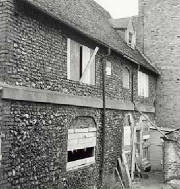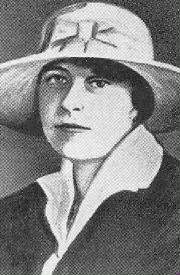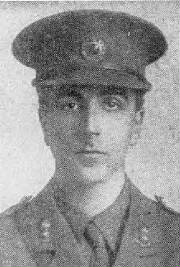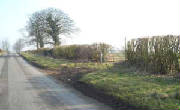|
The Last Customer

Margery Wren, a maiden lady of eighty-two, kept a small general shop in Church Road, Ramsgate, and lived
there by herself. On a Saturday evening in September 1930 she was found lying grieviously injured on the floor of the shop.
"I have just had a tumble, that's all," she gasped. This was plainly untrue - something more sinister and terrible than an
accident had happened. Miss Wren had, in fact, been savagely beaten about the head with a pair of fire tongs; there had also
been an attempt to strangle her. Whatever the motive it was certainly not robbery; all Miss Wren's small possessions were
intact. The old lady was removed to hospital. As her life ebbed away there were times when she was not only conscious but
was able to stammer out a few disconnected sentences. She said enough to convince the police that she knew the man who had
atacked her, and could have given them the name had she wished. She died the next day without uttering it. In her last moments
Miss Wren murmered, " You say I am dying - well that means I am going home." After a long pause she added, "Let him live in
his sins." At the inquest a verdict of "Wilful murder by a person or persons unknown" was returned. Miss Wren had carried
with her to her grave the secret of the murder. There it has remained ever since
work cited:
E. Spencer Shew, pub. 1962, Alfred E. Knopf
Will The Owner Of A Green Bicycle

Ronald Vivian Light, one of the two central figures in the celebrated
'Green Bicycle' case, offers an instructive example of how a man innocently involved in a murder inquiry ought not
to behave. From the following account of the case it will be seen that there is nothing in his conduct which disturbs the
perfect pattern of folly. At about 6.30pm on the 5th July 1919, Annie Bella Wright, the other central character,
set out on her bicycle to visit her uncle, George William Measures, a roadman who lived at Gaulby, a peaceful hamlet then
typical of the hunting country around Leicester. Miss Wright lived with her parents at Stoughton, about five miles away.She
was a strong, good looking girl, twenty-one years old, quiet and sensible; formerly a domestic servant, she had been working
for the past two years at St Mary's Rubber Mills in Leicester. At about 7.30pm she arrived at Mr. Measures' cottage. With
her was a young man on a green bicycle, who waited outside whilst she went in to see her uncle. It happened that Mr. Measures'
son-in-law, a miner named James Evans, was there on a visit. Both he and Mr. Measures were naturally curious to know who the
mysterious stranger was. Miss Wright said she knew nothing at all about the man; he had overtaken her on the road and she
had passed the time of day with him in a casual way. Perhaps if she waited a little while he would go away. But when the time
came for her to leave, the man was still there. As Miss Wright came out he made a remark to her which somewhat startled Mr.
Measures. " Bella, you were a long time," he said. "I thought you were gone the other way." Both Mr. Measures and his
son-in-law were quite certain the the man said "Bella" - not "Hello", as was afterwards suggested. The point was to assume
some importance, since, on the face of it, the use of her Christian name would seem to contradict Miss Wright's statement
that the man was a complete stranger to her. The two of them rode away together. Both Mr. Measures and Mr. Evans put the time
as 'about a quarter to nine', but it was probably somewhat later than that. What is indisputable is that at about 9.20pm,
the dead body of Annie Bella Wright was found lying in the middle of the Gartree Road, the old Roman road - also called the
Via Devana - rather more than two miles from Gaulby. Miss Wright's body was moved to the nearby chapel in Little
Stretton where it lay overnight, thus destroying valuable scene-of-crime forensic evidence.
It was first assumed that Miss Wright had met her death as the result of a bicycle accident, but the local constable,
P.C. Hall, was not entirely satisfied. Early the next morning he returned to the scene of the supposed accident, and after
a close search discovered a revolver bullet half embedded in the roadway. A closer medical examination revealed that Miss
Wright had been shot through the head, and from the character and direction of the wound it appeared that she might have
been lying on her back in the road when she was shot. There was no scorching of the face, which argued that the bullet had
been fired at a range of not less than five feet. This discovery transformed an ordinary routine inquiry into a nation-wide
murder hunt - for the man with the green bicycle. Scotland Yard was called in, but despite the most exhausting efforts, more
than seven months passed by without bringing a solution any nearer; both man and bicycle had effectively vanished. Then on
23rd February 1920, a boatman who was taking a load of coal through the canal at Leicester noticed his tow-rope slacken, dip,
and then, as it tautened again, drag up from below the surface the frame and front wheel of a green bicycle. It hung suspended
from the rope for a moment then slipped back in. The next day the boatman went back to the spot and fished it out. Subsequent
dragging by the police recovered other parts of the machine, and also a revolver holster with live cartridges in it. All the
usual marks of identification had been scraped off the bicycle - that is, all except one, the serial number 103,648 on the
pillar of the handlebar bracket. By means of this number the purchase of the bicycle was traced to one Ronald Light, who had
formerly been living with his mother in Leicester, but who was now an assistant master at a school in Cheltenham.
To the police officers who went there to question him Light denied (1) that he had ever owned a green bicycle; (2) that
he had ever been in the Gaulby district on the day of the murder; (3) that he had ever seen Bella Wright. Light was taken
back to Leicester, where he was identified by Mr. Measures and Mr. Evans as the stranger who had called at the cottage with
Miss Wright. He was put on trial at Leicester Assizes before Mr. Justice Horridge in the following June,
where he was defended by Sir Edward Marshall Hall KC. and by Mr. Norman Birkett
(afterwards Lord Birkett). During a five-hours ordeal in the witness box, Light told a detailedstory of how he had spent
the evening of 5th July. He said that after calling upon some friends of his mother in Leicester he had gone for a bicycle
ride in the country. Having gotten as far as Little Stretton, he had made to return home by the Upper Road; this was not the
quickest way back, but he had not been in any particular hurry. It was then that he had encountered Bella Wright - a complete
stranger to him. He went on:
As I got up to the young lady she was stooped over her bicycle and she looked up at my approach and
asked me if I could lend her a spanner. I had no spanner with me, and I just looked at her bicycle. As far as I could see,
from what she pointed out to me, there was a certain amount of play in the free-wheel. I could not do anything to it as I
had no spanner. After that we rode on together. We came to a village. I asked her the name of the village, and she said it
was Gaulby.... She told me that she was going to see some friends there. She said "I shall only be ten minutes or a quarter
of an hour", so we rode into the village together, and I went with her, as far as far as the house where she was going"
|
 |
|
 |
 |
|
|
|
related internet links
|
|
the museum was started as
a collection of police memorabilia
and history
and other places.
a lovely collection, and you
can buy them too
Kent - Nord Pas de Calais
maritime history along the
Channel coasts of
England and France
a civic society and historical group
which aims to take care of the town
to help make it a better place in which to live
work and enjoy life
|
|
 |
 |
 |
 |
|

|
| . |
|
|
related internet links
|
|
An account by H.L.Adam
in The Fifty Most Amazing Crimes
of the last 100
years.
published in 1936
an overview of the case from
the Leicester Chronicler, a website
dedicated to the historic heartbeat of
the City of Leicester and its environs

|
| Gartree Road. Bella Wright was found in the road, her bicycle lying a short distance from her. |
|
|
 |
 |
|
 |
 |
 |
|
|
 |
 |
 |
|
|
|

